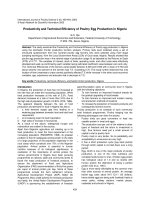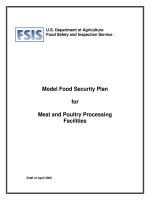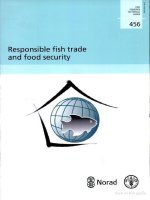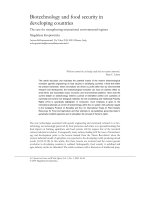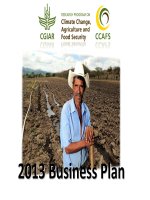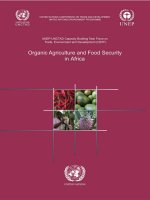Resource Quality- Agricultural Productivity and Food Security ppsx
Bạn đang xem bản rút gọn của tài liệu. Xem và tải ngay bản đầy đủ của tài liệu tại đây (36.34 KB, 10 trang )
Resource Quality, Agricultural Productivity, and Food Security
Stacey Rosen and Keith Wiebe
USDA Economic Research Service
Washington, DC
American Agricultural Economics Association
Selected Paper, Chicago, August 2001
Copyright 2001 by Stacey Rosen and Keith Wiebe. All rights reserved. Readers may make
verbatim copies of this document for non-commercial purposes by any means, provided that this
copyright notice appears on all such copies.
Resource Quality, Agricultural Productivity, and Food Security
Stacey Rosen and Keith Wiebe
USDA Economic Research Service
Washington, DC
AAEA Selected Paper, Chicago, August 2001
Introduction
Global food production has grown faster than the world's population over the past forty years.
Yet many poor countries and millions of poor people continue to suffer from food insecurity and
hunger. USDA’s Economic Research Service (ERS) estimates that a third of the population of
67 developing countries—roughly 900 million people—currently suffer from insufficient food
intake. Also, the amount of food needed to secure nutritionally adequate diets for these people
was estimated at more than 17 million tons in 2000 and is projected to grow by 70 percent over
the next decade. Sub-Saharan Africa, the most vulnerable region, is projected to account for
almost 80 percent of this ‘nutritional gap’ in 2010.
For many developing countries, growth in agricultural productivity is critical to improvements in
food security for two reasons. First, growth in agricultural productivity translates into larger
food supplies and lower food prices for all consumers. This is particularly true in many of the
poorest countries, which depend heavily on domestic food production for a large part of their
food because financial constraints limit imports. In Sub-Saharan Africa, for example, domestic
production accounts for 90 percent of food availability on average. Second, growth in
agricultural productivity means higher incomes, and thus improved ability to purchase food, for
the large share of low-income countries’ populations that depend on agriculture for their
livelihoods.
Agricultural productivity depends in turn on the quantity and quality of resources used in
agricultural production. Data on resource quality have historically been scarce, but recent
improvements have allowed a more complete understanding of how land quality in particular
affects productivity and food security. In this paper, we examine the factors underlying observed
disparities in agricultural productivity across countries, including land quality, and review
patterns in input use over time. We then incorporate results from these analyses in ERS’s food
security assessment model to project trends in food security across regions and explore the
sensitivity of these projections to changes in input use. Two specific scenarios are modeled: a
reduction in the rate of agricultural expansion and an adjustment in the response of yields to
fertilizer applications based on differences in land quality.
Factors underlying agricultural productivity
Most studies indicate that observed differences in agricultural productivity can be attributed
largely to differences in the quantity of conventional inputs used in agricultural production, such
as land, labor, fertilizer, and machinery. Frisvold and Ingram (1995), for example, found that
conventional inputs—especially labor—accounted for two thirds of growth in the productivity of
agricultural land in Sub-Saharan Africa in the 1970s and 1980s.
While input quantities are certainly important, agricultural productivity also depends
significantly on the quality of inputs used, including the quality of natural resources such as land.
Distinguishing the relative impacts of input quantity and quality is not easy, but it is essential in
determining appropriate policy measures to improve agricultural productivity and food security.
Land quality is of particular importance because it not only affects yields directly (e.g. via
differences in soil depth, fertility, and water-holding capacity), but it also affects how yields
respond to other inputs, such as fertilizer. Recognition of differences in land quality is thus
critical to the explanation of observed productivity differences and the identification of
appropriate policy responses.
Using information on soils, climate, and land cover, researchers at ERS recently examined the
quality of cropland by country and region (Wiebe et al. 2000). They found that while the
average quality of all land is generally lowest in the Middle East and North Africa, the average
quality of cropland is lowest in Sub-Saharan Africa. Among 38 Sub-Saharan African countries
studied, only about six percent of cropland, on average, was classified as highly suitable for
agriculture. By contrast, high-quality land constituted an average of 16 percent of cropland in
Asia, 19 percent in the Middle East and North Africa, 27 percent in Latin America, and 29
percent in the high-income countries (as defined by the World Bank 1999).
Land quality and agricultural productivity
Land quality differences help explain agricultural productivity differences across countries and
regions. Land quality can also vary over time, improving or deteriorating as a result of
environmental conditions and farm management practices. As population has grown in many
developing countries, agricultural land has come under increasing pressure. Farmers have
expanded onto marginal lands and intensified production on lands already cultivated. In some
cases poverty, insecure land tenure, inappropriate agricultural policies, and other factors have
resulted in inappropriate management practices. In many areas, nutrients have been depleted
from soils and yields have stagnated, especially where fertilizer use is low and nutrient loss is
high. In Sub-Saharan Africa, for example, fertilizer application rates average around 10
kilograms per hectare per year, compared with 99 kilograms in Latin America, 117 kilograms in
North Africa, and 135 kilograms in Asia (FAO 2001). According to IFPRI, soils in most African
countries lose more than 30 kilograms of nitrogen, phosphorus, and potassium (NPK) per hectare
per year, and losses exceed 60 kilograms per year in much of Western and Eastern Africa (Henao
and Baanante 1999). Nutrient losses on a similar scale have recently been identified in many
parts of Latin America as well (Wood, Sebastian, and Scherr 2000).
To explore the link between land quality and the productivity of agricultural land, Wiebe and
Tegene (2000) recently combined information on soil and climate quality with data on land,
labor, fertilizer, and other inputs in an econometric analysis of 110 countries over the period
1961-1997. They found that differences in agricultural land productivity are significantly related
to differences in the quality of agricultural land. Within Sub-Saharan Africa, the productivity of
agricultural land is 28 percent higher, on average, in countries with relatively high land quality
than it is in countries with poor land quality. The productivity differential attributable to high
land quality is 34 percent in Asia, and 22 percent in high-income countries.
As expected, land quality also affects the impact of other inputs on agricultural productivity. In
Sub-Saharan African countries with good soils and climate, for example, agricultural land
productivity rises significantly with increases in quantities of labor, livestock, tractors, fertilizer,
and annual rainfall. Productivity also improves with irrigation, labor quality (in the form of
longer life expectancy and higher literacy rates), and transportation infrastructure, and falls
significantly with the occurrence of armed conflict. In Sub-Saharan countries with poor soils
and climate, the results are mixed. Productivity responds even more strongly to fertilizer,
irrigation, and political instability than it does in the countries with good soils and climate, but is
not sensitive to improvements in tractors, labor quality, or infrastructure.
The results indicate that in countries poorly endowed with soils and climate, basic inputs such as
fertilizer, water (or irrigation), and institutional stability are more important than they are in
countries that are relatively well endowed in terms of natural resources. Most farmers in
resource-poor areas are subsistence producers with limited participation in commercial markets.
This suggests that until these basic resource constraints are removed, improvements in labor
quality, transportation, and mechanization may have only a limited impact on agricultural
productivity. Improvements in policy and reductions in armed conflict are essential in both sets
of countries.
These findings suggest an important role for land quality and agricultural productivity in refining
our understanding of food security. This role is explored after a brief overview of ERS’s food
security assessment research.
Food security assessment
ERS’s food security assessment (FSA) model is a partial-equilibrium simulation model used to
project food availability in 67 developing countries in five regions (North Africa, Sub-Saharan
Africa, Asia, Latin America, and the New Independent States (NIS) of the former Soviet Union)
(Shapouri 2000). Each country model includes three commodity groups: grains, root crops, and
other crops. The production side of the grain and root crops consists of yields (a function of
input use) and area responses. Commercial imports are assumed to be a function of domestic
prices, world commodity prices, and foreign exchange availability.
Food security is assessed by measuring the size of and trends in several alternative food gaps.
The status quo gap is estimated as the amount of food needed to support 1997-99 levels of per
capita consumption for each country, while the nutritional gap is the gap between available food
and food needed to support a target per capita nutritional standard. However, the aggregate food
availability projections do not account for food security problems due to food distribution
difficulties within a country, so we also project food consumption by different income groups
based on income distribution data for each country. The concept of an income-consumption
relationship is used to allocate the projected level of food availability among different income
groups. The estimated distribution gap measures the amount of food needed to raise the food
consumption of each income quintile to the nutritional standard. Finally, based on the projected
population, we project the number of people who cannot meet their nutritional requirements.
The baseline results of the food security assessment project that nutritional and status quo food
gaps will grow over the next decade. However, the number of people who will be unable to meet
nutritional requirements will decline. These results suggest that nutritional problems among the
food insecure population will intensify more than the food deficits will spread. In other words,
the hunger problem will become more severe in the vulnerable countries and/or among the lower
income groups.
Linking land quality, agricultural productivity, and food security
Over the past four decades, growth in agricultural production at a global scale has come
predominantly from increases in yields, and this pattern is projected to continue in the future
(FAO 2000). In many low-income countries, however—particularly in Sub-Saharan Africa—
yields have stagnated in recent years and most increases in agricultural output have stemmed
from area expansion (table 1) (FAO 2001). While additional land was available to be brought
into food production, in most countries it was marginal land with lower productivity, more
uncertain rainfall, and potentially greater vulnerability to degradation, implying lower and more
variable crop yields. Moreover, area growth cannot be sustained indefinitely, since continued
conversion of range and forestland to cropland involves increasingly high economic and
environmental costs. In Asia, nearly 80 percent of potentially arable land is already cultivated.
These trends imply that for most food-insecure countries, particularly those in Sub-Saharan
Africa and Asia, land constraints will play an increasingly important role in determining food
security in the future. To explore the possible impacts of land constraints on food security, we
compared the FSA baseline results with two alternative scenarios: (1) reduced growth in area
planted, to reflect rising costs of land conversion as well as cropland lost to land degradation;
and (2) variation in region-specific yield response to fertilizer use, adjusted for regional
differences in land quality.
Table 1: Growth in factors of production, 1980-99
Region
Area
Yield
%/year
North Africa 0.5 3.0
Sub-Saharan Africa* 2.2 0.4
Asia 0.1 2.4
Latin America 0.7 0.4
*these figues are exclusive of Nigeria; because of the size of the
Nigerian numbers, their trends heavily skew the results of the region.
Scenario 1: Reduced area growth
Agricultural land in Asia, Africa, and Latin America has expanded by about 6 million hectares
per year over the past four decades (FAO 2001). Data on land degradation at a global scale are
scarce, but recent estimates suggest that some 5-6 million hectares of agricultural land worldwide
are lost each year as a result of soil erosion, salinization, and other processes (Scherr 1999). If
half of that degradation occurs in developing regions, effective area growth in those regions
would be about half the rate apparent in simple historic trends. Accordingly, in our first
scenario, area expansion is assumed to be half the rate used in the base model for North Africa,
Sub-Saharan Africa, Latin America, and NIS. In Asia, where average annual area growth has
fallen to negligible levels in recent years, area is assumed to remain constant (table 2).
Under the baseline assumptions, the number of people whose consumption falls short of the
nutritional target in 2010 is projected to be roughly 700 million—or 22 percent of the total
population—for the 67 countries. Under the reduced area growth scenario, this number rises
dramatically to 1.1 billion—or a third of the population of the 67 countries (fig. 1). In this
scenario, production growth falls to 1.5 percent per year, compared with 1.8 percent in the
baseline projections.
Table 2: Growth in factors of production, 2000-10
Baseline
Scenario 1
Scenario 2
Region
Area
Yield
Area
Yield
Area
Yield
%/year %/year %/year
North Africa 1.65 0.27 0.81 0.66 2.59 0.76
Sub-Saharan Africa 1.18 1.29 0.59 1.18 1.20 1.32
Asia 0.09 1.58 0.00 1.39 0.02 1.08
Latin America 0.63 1.08 0.35 1.04 0.41 0.76
NIS
0.73
1.02
0.36
0.88
1.37
2.30
For Sub-Saharan Africa, production under the baseline run was projected to rise at a rate of 2.2
percent per year; under the reduced area growth scenario this growth rate is projected to slow to
1.8 percent. As a result, the nutritional gap in 2010 jumps 34 percent above that of the baseline
scenario. In addition, the number of people with inadequate diets in 2010 jumps 15 percent
relative to the base scenario, and consumption is projected to exceed the nutritional standard only
in the highest income group.
In Asia, the results varied widely by country. While this scenario did not generate much change
in production growth rates for the region as a whole, for certain countries like Afghanistan,
Indonesia, North Korea, and Pakistan, the reduction in area growth did have an impact. In these
countries, area growth was projected to be a significant contributor to production performance in
the baseline run. As a result of the changes in these countries, the region’s per capita
consumption growth through 2010 was cut by more than half—from 0.5 percent per year to 0.2
percent under this scenario. Consequently, consumption is projected to fall short of the
nutritional standard for 23 percent of the population by 2010. In the baseline scenario, this
number was only 9 percent. Reduced area growth also resulted in large increases in food gaps in
Latin America, despite that region’s high import capacity—and therefore lower relative
dependence on domestic production.
Scenario 2: Land quality-adjusted fertilizer response
To capture findings that land quality influences the response of yields to inputs such as fertilizer,
we modified the FSA model to incorporate region-specific fertilizer response coefficients. These
coefficients were derived from the multi-country productivity analysis described earlier,
Fig. 1:
Percent of Population Hungry in 2010
0
10
20
30
40
50
60
70
80
North Africa Sub-Saharan
Africa
Asia Latin America NIS
Percent
Base Scenario 1 Scenario 2
modified to match the FSA model’s specification of yields as a function of labor, fertilizer, and
technology. To account for differences in soils and climate, labor and fertilizer levels were first
estimated as functions of land quality, labor quality, conflict, and transportation infrastructure.
The baseline model assumed a uniform fertilizer response of 0.2 for all regions, based on
estimates from earlier studies. By contrast, estimated resource quality-adjusted fertilizer
response coefficients are 0.04 for Asia, 0.55 for North Africa and NIS, 0.13 for Latin America,
and 0.24 for Sub-Saharan Africa. These coefficients imply that a one-percent increase in
fertilizer use, holding everything else constant, will result in a 0.24-percent increase in the
productivity of agricultural land in Sub-Saharan Africa, for example, but only a 0.04-percent
increase in Asia. These results are intuitively consistent with the fertilizer application rates noted
earlier, with low initial application rates indicating relatively large marginal responses in Sub-
Saharan Africa, and the converse in Asia.
When applied to the FSA model, the negligible estimated fertilizer response for Asia results in a
precipitous decline in the region’s production growth rate relative to the baseline projections.
This change, in turn, generates a 47-percent increase in the region’s 2010 status quo food gap
relative to the baseline run. Moreover, as a result of the reduced growth in production,
consumption levels are projected to fall relative to those in the baseline projections; consumption
in 2010 is projected to fall below the nutritional target for 36 percent of the region’s population
(compared with 9 percent in the baseline projection). For Latin America the results under this
scenario do not change significantly relative to the base scenario because the change in the
fertilizer response coefficient was small and because this region is highly dependent on imports
(the region’s import dependency averaged roughly 45 percent in the late 1990’s, compared with
5 percent in Asia and 10 percent in Sub-Saharan Africa).
In the two cases where the fertilizer response rose, the resulting changes were also modest.
Production growth did rise in North Africa and NIS, but because the countries in these regions
are more import dependent than those in Asia, this change did not have as strong an impact on
overall consumption levels, food gaps, and numbers of hungry people. Sub-Saharan Africa is
much more dependent on domestic production, as noted earlier, but the estimated resource
quality-adjusted fertilizer response—at 0.24—was only slightly higher than the level assumed in
the baseline projections. As a result, projected food security outcomes for the region did not
change significantly from those in the baseline.
Policy lessons
More work needs to be done to test the sensitivity of these results to alternative land quality
indicators, functional forms, and econometric specifications. Nevertheless, these preliminary
findings suggest the importance of recognizing the links between land quality, agricultural
productivity, and food security. In particular, increased attention needs to be addressed to
changes in resource quality over time. Adjusting projections of growth in agricultural land area
to reflect land degradation sharply reduces production growth and increases the magnitude of
food gaps. Adjusting projections of growth in yields to reflect differences in fertilizer response
(due to a combination of land quality, current fertilizer application levels, and other factors) has
marked food security implications in some regions but not in others. In general, the two
scenarios indicate the need for further work in these hitherto distinct areas of research.
They also suggest several areas that deserve priority in seeking to reduce or avert projected food
gaps. First, they indicate the importance of removing macro policy distortions and infrastructure
constraints that make essential inputs, such as fertilizer and water, prohibitively expensive for
many small-scale farmers in developing countries (even in the absence of these distortions and
constraints, basic climate and geographic conditions will make water availability costly in less
favorable areas). Several studies document that the timely physical availability of fertilizers to
farmers, in appropriately-sized packages, remains the main constraint to increasing fertilizer use
in Sub-Saharan Africa. An adequate fertilizer supply at the farm level remains essential for
maintaining reasonable fertilizer costs even when domestic prices are tied to world prices
without subsidies. Improved marketing systems, particularly through increased private
marketing and better infrastructure, will reduce farm-gate prices of fertilizers, regardless of their
origin.
Second, research on farm management practices that protect and improve the quality of the land
resources on which agriculture depends, and extension efforts to share these practices with
farmers needs to be encouraged. To maximize the benefit of fertilizers, application must be
combined with soil conservation, recycling of crop residues, livestock management, and the use
of organic fertilizers. If fertilizer supplies are going to continue to be unreliable or prohibitively
costly, then viable substitutes for commercial fertilizers need to be adopted that would achieve
the same goal of increasing yields. Besides the established practice of using livestock manure,
legume rotations are being experimented with in some parts of the region as well as the planting
of leguminous trees interspersed with crops. Using new plants as a green manure source is also
being explored as an alternative to traditional practices. However, these practices require
sacrificing area in food crops and applying additional labor.
Finally, improvements in land quality and productivity are not likely to be sustained in the
absence of property rights that protects farmers’ incentives to invest in their land. Individual
private ownership is not a necessary condition; research increasingly shows that such incentives
can be protected under a variety of tenure systems, including share leasing in the United States
and customary tenure systems in Sub-Saharan Africa. Rather, what is critical is what is too often
lacking in many developing countries: a sound and stable institutional structure. In many cases,
this may constitute the most fundamental challenge to efforts to improve land quality,
agricultural productivity, and food security (Soule, Tegene, Wiebe, 2000; Bruce, Migot-Adholla,
1994).
References
Bruce, John W., and Shem E. Migot-Adholla (1994). Searching for Land Tenure Security in
Africa. Dubuque, Iowa: Kendall-Hunt Publishing (for the World Bank).
Frisvold and Ingram (1995). “Sources of agricultural productivity growth and stagnation in sub-
Saharan Africa.” Agricultural Economics 13: 51-61.
Henao, J. and Carlos Baanante (1999). Nutrient Depletion in the Agricultural Soils of Africa.
International Food Policy Research Institute, 2020 Brief 62, October.
Scherr, Sara (1999). Soil Degradation: A Threat to Developing Country Food Security by 2020?
International Food Policy Research Institute. Food, Agriculture, and the Environment
Discussion Paper No. 27, Washington, DC, February.
Shapouri, Shahla (2000). “Global Food Security: Overview.” Food Security Assessment,
International Agricultural and Trade Reports, Situation and Outlook Series, GFA-12,
United States Department of Agriculture, Economic Research Service, December.
Soule, Meredith, Abebayehu Tegene, and Keith Wiebe (2000). "Land Tenure and the Adoption
of Conservation Practices." American Journal of Agricultural Economics 82(4): 993-
1005, November.
United Nations Food and Agriculture Organization (2000). Agriculture Towards 2015/2030.
InterimTechnical Report, Rome.
United Nations Food and Agriculture Organization (2001). Agrostat.
Wiebe, Keith D.; and Abebayehu Tegene (2000). “Resource Quality, Agricultural Productivity
and Food Security in Developing Countries.” Food Security Assessment, International
Agricultural and Trade Reports, Situation and Outlook Series, GFA-12, United States
Department of Agriculture, Economic Research Service, December.
Wiebe, Keith, Meredith Soule, Clare Narrod, and Vince Breneman (2000). “Resource Quality
and Agricultural Productivity: A Multi-Country Comparison.” Selected Paper, American
Agricultural Economics Association, August.
Wood, Stanley, Kate Sebastian, and Sara J. Scherr (2000). Pilot Assessment of Global
Ecosystems: Agroecosystems. Washington, DC: IFPRI and WRI.
World Bank (1999). World Development Indicators. Washington, DC: World Bank.
